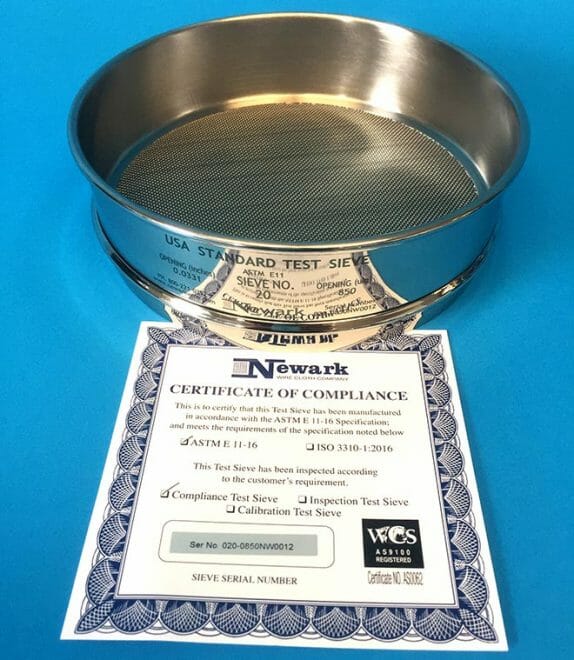
Of all the uses for wire cloth and mesh, one of the most demanding is the test sieve. They are manufactured to different confidence levels of accuracy and used to measure particle sizes of organic or non-organic granular materials. As such, knowing what quality standards are needed in a test sieve is important. First, let’s briefly review a few types of available test sieves and their uses.
Types of test sieves
- Test sieves must meet certain ASTM global standards for particle measurement. A sieve’s confidence level is determined by the quality of its manufacture and the opening size of its wire cloth or mesh. These are three commonly used test sieves.
- Compliance test sieves are built to a confidence level of 66 percent. This means the sieve cloth used was inspected prior to being mounted in the sieve frame.
Inspection test sieves are built to a confidence level of 99 percent. This means the sieve cloth used was inspected and its openings measured in both the warp and shute direction after being mounted in the sieve frame. - Calibration test sieves are built to a confidence level of 99.73 percent. This means the sieve cloth used was inspected and its openings and wire diameters measured in both the warp and shute direction after being mounted in the sieve frame. At least twice as many openings are measured as compared to inspection test sieves. When U.S. standard #400 wire or finer is used, three times as many openings are measured as compared to inspection test sieves. This makes them extremely accurate for particle size sieve analysis.
Sifting for the facts:
In the food, pharmaceutical and chemical industries, particle size distribution sieve analysis is used for production and quality control in everything from diamonds to coffee beans. The particle size distribution – meaning the number of particles of various sizes, is responsible for important physical and chemical properties that impact product quality and performance. A few examples of these include:
- Concrete strength
- The taste of chocolate
- Tablet dissolution
- The solubility of washing detergents
For producers of bulk goods with different forms and sizes, understanding their particle size distributions is essential. Typically test sieves are placed in stacks of increasingly smaller wire cloth or mesh openings, then agitated to separate the particles for inspection and weight.
Quality and Characteristics
The quality requirements and characteristics of test sieves depends on the application. These are a just few inspection methods and general quality characteristics to look for:
- Space cloth – Use a ruler to check the distance from the inner edges of two adjacent, parallel wires
- Coarse mesh cloth – Use a ruler to count the openings in one linear inch, starting at the center of any wire
- Medium mesh cloth – Use a counting glass to count the openings per linear inch from wire center to center both horizontally and vertically
- Wire diameter – Inspect the warp and shute with a micrometer caliper for accuracy and a magnifying glass to confirm the wires are parallel and review crimping quality
- There are no rivets on the inside frame surface
- The interior and exterior frame is polished
- There is a smooth transition from the sieve frame sidewall to the sieving surface
In review
To summarize a few important facts about test sieves:
- A sieve analysis test assesses the particle size distribution of a granular material
- Certified test sieves must meet rigorous international standards
- Test sieves can be configured to meet almost any application
SaniClean Strainers, a Newark Wire brand, manufactures and offers a complete line of test sieves, wire cloth and industrial 3A certified strainers, assemblies, replacement parts, and filter media suitable for a wide range of applications and capacities. Contact our experts today and get the reliable test sieves, wire cloth products ensured to work for your next filtration project.
